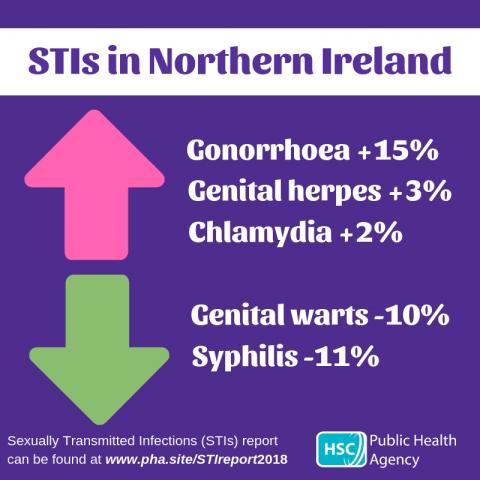Public reminded of safer sex messages as new STI stats revealed

The latest sexual health figures released today by the Public Health Agency (PHA) show an increase in cases of gonorrhoea, herpes and chlamydia, while numbers diagnosed with syphilis and genital warts are down.
The ‘Sexually Transmitted Infection surveillance in Northern Ireland 2018: An analysis of data for the calendar year 2017’ report shows that there was a 1% overall increase in sexually transmitted infections (STIs) diagnosed through Genitourinary Medicine (GUM) clinics compared with 2016.
The report shows:
- 5,726 new STI diagnoses were made in 2017, compared with 2016 (5,719);
- New diagnoses of gonorrhoea increased by 15%: 679 in 2017 compared with 592 in 2016;
- New diagnoses of genital herpes simplex (first episode) increased by 3%: 463 in 2017 compared with 448 in 2016;
- New diagnoses of infectious syphilis decreased by 11%: 50 in 2017 compared with 56 in 2016;
- New diagnoses of genital warts (first episode) decreased by 10%: 1,600 in 2017 compared with 1,786 in 2016;
- New diagnoses of chlamydia increased by 2%: 1,684 diagnoses in 2017 compared with 1,648 in 2016.
Dr Claire Neill, Specialist Registrar with the PHA, said: “By having unprotected sex, you could effectively be sleeping with everyone your partner’s ever slept with, putting yourself at risk of getting an STI. We are urging people to always use a condom, and to get tested if they have put themselves at risk.
People with STIs don’t always have symptoms, so anyone having unprotected sex could be putting their health at risk.
“It is also important to take steps to reduce the risk of harm to yourself and others if there’s a chance you have contracted an STI. There are GUM clinics across Northern Ireland, so if you have put yourself at risk, make sure you attend one of these clinics to get checked out for free.”
2017 saw a 15% increase in the number of diagnoses of gonorrhoea made in GUM clinics with 679 diagnoses made – the highest number reported in Northern Ireland to date. The report shows that the highest rates of STIs occur in 16-34 year olds.
“People should take every precaution necessary to help protect themselves. For example, we are seeing a reducing trend in genital warts here, in particular among 16-19 year-old females, reflecting the success of the Human Papilloma Virus (HPV) vaccine in this group,” Dr Neill continued.
“We urge parents of girls who are eligible to receive the HPV vaccine to make sure that they get it to reduce their risk of developing cervical cancer and genital warts in later life. The vaccine is offered to girls in years 9 and 10 through a school-based programme.”
Information on looking after your sexual health, symptoms of STIs (as well as information on STIs which may be symptomless) and details of Northern Ireland GUM clinics can be found at www.sexualhealthni.info
The ‘Sexually Transmitted Infection surveillance in Northern Ireland 2018: An analysis of data for the calendar year 2017’ report can be found at www.pha.site/STIreport2018
A leaflet on the HPV vaccine can be found at www.pha.site/hpv2018
